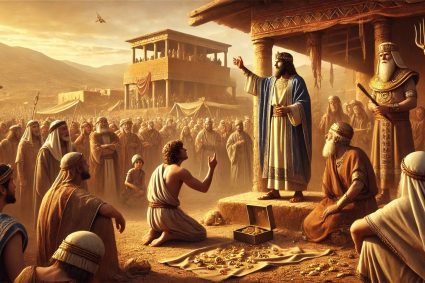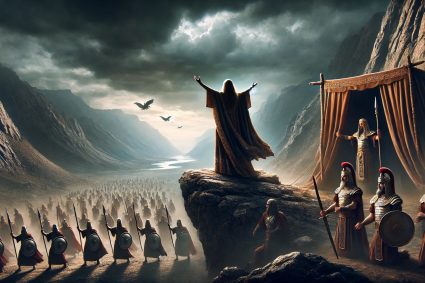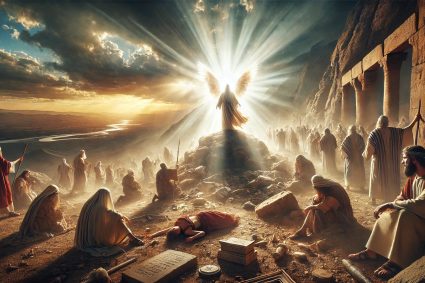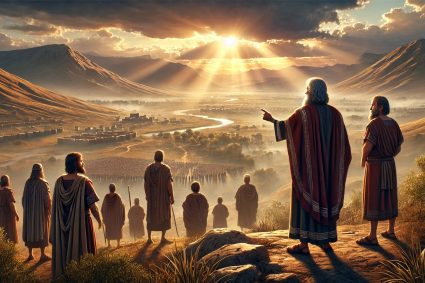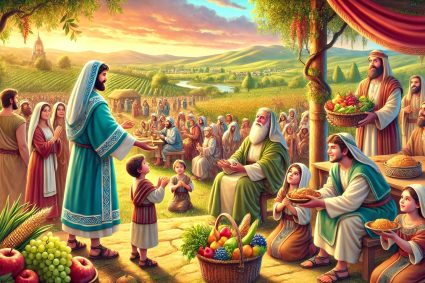
August 16, 2024
DAILY BIBLE READING – Matthew Chapter 17
1 And after six days Jesus taketh Peter, James, and John his brother, and bringeth them up into an high mountain apart,
2 And was transfigured before them: and his face did shine as the sun, and his raiment was white as the light.
3 And, behold, there appeared unto them Moses and Elias talking with him.
4 Then answered Peter, and said unto Jesus, Lord, it is good for us to be here: if thou wilt, let us make here three tabernacles; one for thee, and one for Moses, and one for Elias.
5 While he yet spake, behold, a bright cloud overshadowed them: and behold a voice out of the cloud, which said, This is my beloved Son, in whom I am well pleased; hear ye him.
6 And when the disciples heard it, they fell on their face, and were sore afraid.
7 And Jesus came and touched them, and said, Arise, and be not afraid.
8 And when they had lifted up their eyes, they saw no man, save Jesus only.
9 And as they came down from the mountain, Jesus charged them, saying, Tell the vision to no man, until the Son of man be risen again from the dead.
10 And his disciples asked him, saying, Why then say the scribes that Elias must first come?
11 And Jesus answered and said unto them, Elias truly shall first come, and restore all things.
12 But I say unto you, That Elias is come already, and they knew him not, but have done unto him whatsoever they listed. Likewise shall also the Son of man suffer of them.
13 Then the disciples understood that he spake unto them of John the Baptist.
14 And when they were come to the multitude, there came to him a certain man, kneeling down to him, and saying,
15 Lord, have mercy on my son: for he is lunatick, and sore vexed: for ofttimes he falleth into the fire, and oft into the water.
16 And I brought him to thy disciples, and they could not cure him.
17 Then Jesus answered and said, O faithless and perverse generation, how long shall I be with you? how long shall I suffer you? bring him hither to me.
18 And Jesus rebuked the devil; and he departed out of him: and the child was cured from that very hour.
19 Then came the disciples to Jesus apart, and said, Why could not we cast him out?
20 And Jesus said unto them, Because of your unbelief: for verily I say unto you, If ye have faith as a grain of mustard seed, ye shall say unto this mountain, Remove hence to yonder place; and it shall remove; and nothing shall be impossible unto you.
21 Howbeit this kind goeth not out but by prayer and fasting.
22 And while they abode in Galilee, Jesus said unto them, The Son of man shall be betrayed into the hands of men:
23 And they shall kill him, and the third day he shall be raised again. And they were exceeding sorry.
24 And when they were come to Capernaum, they that received tribute money came to Peter, and said, Doth not your master pay tribute?
25 He saith, Yes. And when he was come into the house, Jesus prevented him, saying, What thinkest thou, Simon? of whom do the kings of the earth take custom or tribute? of their own children, or of strangers?
26 Peter saith unto him, Of strangers. Jesus saith unto him, Then are the children free.
27 Notwithstanding, lest we should offend them, go thou to the sea, and cast an hook, and take up the fish that first cometh up; and when thou hast opened his mouth, thou shalt find a piece of money: that take, and give unto them for me and thee.
King James Version. Public Domain
Commentary
Introduction
Matthew Chapter 17 contains some of the most profound and significant events in the life of Jesus, revealing both His divine nature and the challenges He faces. This chapter includes the Transfiguration of Jesus, the healing of a boy with seizures, the second announcement of Jesus’ suffering and resurrection, and the discussion about paying the temple tax. Each of these events contributes to deepening the disciples’ understanding of Jesus’ true identity and mission.
Commentary
The chapter begins with the Transfiguration of Jesus, an event where Jesus takes three of His closest disciples—Peter, James, and John—up a high mountain. There, He is transfigured before their eyes, with His face shining like the sun and His clothes becoming dazzlingly white. The appearance of Moses and Elijah, speaking with Jesus, symbolizes His connection to the Law and the Prophets, while God’s voice from the cloud announces Jesus as His beloved Son, to whom they should listen. This scene underscores Jesus’ divine authority and highlights Him as the one who fulfills the Law and the Prophets.
In the healing of the boy with seizures, Jesus demonstrates His power over demonic forces and criticizes the lack of faith among His disciples. He emphasizes that genuine faith, even the size of a mustard seed, can accomplish miracles. This event reveals the gap between the disciples’ trust and the authority Jesus has bestowed upon them.
The second announcement of Jesus’ suffering and resurrection prepares the disciples for the impending suffering of their Master, a theme repeatedly addressed in the Gospels to emphasize the central importance of the cross in Jesus’ mission.
Finally, the chapter addresses the issue of the temple tax, where Jesus performs a miracle to pay the tax. This event illustrates Jesus’ freedom as the Son of God while also demonstrating His willingness to fulfill worldly duties to avoid causing offense.
Summary
Matthew Chapter 17 highlights pivotal moments in the life of Jesus that reveal His divine identity and missionary calling. The Transfiguration emphasizes Jesus’ divine affirmation, the healing of the boy underscores the importance of faith, the second announcement of His suffering prepares the disciples for the coming sacrifice, and the discussion about the temple tax shows Jesus’ wisdom in dealing with worldly obligations. The chapter challenges readers to recognize and accept the deeper meaning of Jesus’ work and His role as the Savior.
![]()

WEEKLY SPIRIT OF PROPHECY READING – Ellen White | The Desire of Ages Chapter 54—The Good Samaritan
This chapter is based on Luke 10:25-37.
Read online here
Commentary
Introduction
Chapter 54 of “The Life of Jesus” delves into the Parable of the Good Samaritan, a story that conveys profound lessons about true religion and neighborly love. Jesus uses this parable to emphasize the importance of compassion and practical love, which go beyond mere formalism. It demonstrates that the true expression of faith lies in the willingness to help others, regardless of their cultural or religious differences. In a time when self-righteousness and exclusion were prevalent, Jesus places the commandment of love above all other commandments.
Commentary
The Parable of the Good Samaritan is one of Jesus’ most profound and instructive parables, revealing the essence of true religion. It is not about outward rituals or formal religious practices, but about the active exercise of love, compassion, and mercy towards others, regardless of their background, faith, or social status. Jesus uses this story to expose the hypocritical attitude of the religious leaders of his time and to highlight the central importance of neighborly love.
The Good Samaritan represents the contrast between theoretical religiosity and practical, living love for one’s neighbor. While the priest and the Levite—religious authorities—pass by the injured man, it is the Samaritan, an outsider, who demonstrates true divine mercy. The parable underscores that true piety is not about distancing oneself from others but about caring for those in need and standing by them in their distress.
Through this parable, Jesus challenges his listeners and all believers to live out God’s love not just in words but in actions. He shows that a true neighbor is not just someone close to us, but anyone who needs our help. This teaching is a call to break down barriers of prejudice and self-righteousness and to cultivate an attitude of impartial mercy.
Summary
The Parable of the Good Samaritan powerfully illustrates the necessity of placing love for one’s neighbor and mercy above formal religious practices. Jesus makes it clear that true religion is not in the mere observance of rituals but in actively helping those in need. The Samaritan, who shows compassion despite cultural hostility, serves as a model of genuine divine love. The parable challenges us to break down barriers and see every person as our neighbor, whom we can help. This teaching remains a timeless reminder that love for God and our neighbor is the essence of the law and the life of faith.

WEEKLY SPIRIT OF PROPHECY READING – Ellen White | The Desire of Ages Chapter 55—Not With Outward Show
This chapter is based on Luke 17:20-22.
Read online here
Commentary
Chapter 55 focuses on Jesus’ central message that the Kingdom of God is not manifested through outward signs or worldly power, but rather begins within the individual. This teaching sharply contrasted with the expectations of the Pharisees and many Jews, who were anticipating a visible, earthly kingdom. Jesus emphasized that the Kingdom of God is a spiritual state that grows in the hearts of believers, independent of external circumstances or worldly forms of government.
Jesus taught his disciples that the true glory of his mission does not lie in worldly splendor, but in the spiritual renewal of individuals through the Holy Spirit. It was only after his ascension and the outpouring of the Holy Spirit that the disciples fully grasped the scope of Jesus’ mission. They came to understand that Christ’s kingdom is not established through earthly laws or power structures, but through the transformation of the heart and the following of Christ.
This message remains relevant today: the Kingdom of God is not built through political power or external reforms, but through inner renewal and living according to the teachings of Christ. Believers are called to seek not worldly glory, but to walk in humility and self-denial, following the path of Christ, who brought true light and life into the world.
(Visited 15 times, 1 visits today)


